The Videogame System Sales Cycle
There's an article over at Asymco.com looking at videogame hardware sales during the last decade.1 It comes to the conclusion that the videogame market is being eaten up by smartphones and tablets. Here's a quote:
It’s one thing to suggest that Nintendo consoles have “failedâ€, it’s another to show that Nintendo consoles and portables have failed, and yet another to show that two competitors in the games business seem to be failing in unison across all their product lines. The cyclicality is also over a long period of time: The peak for the combined Sony/Nintendo was in 2008, five years ago.
No coincidence about the timing of that peak. It coincides with the beginning of the post-PC era.
Let's look at one of the consoles in question. Here's the Wii's yearly sales data:
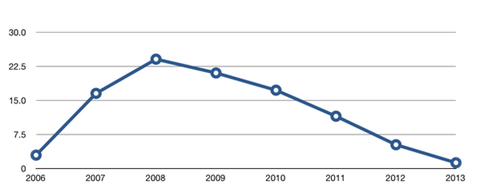
Indeed, there's a peak around 2008, and a steady decline afterwards. Looks terribly suspicious! But before we jump to conclusions, there are two questions that need to be answered.
First, before we argue about what might have caused the Wii's declining sales, we should evaluate whether anything unusual actually happened here.2 In other words, is the Wii's sales cycle atypical for a videogame console, and likely caused by an external factor?
Second, assuming that something unusual did happen to the Wii, what caused it? Is it really "no coincidence" that the Wii's sales peak coincides with the iPhone's release, and the beginning of the "post-PC era", or are there other, more likely factors influencing the Wii's sales?
Humans are pattern seekers. We see patterns everywhere. That's why people see the golden ratio everywhere, even when nobody put it there. If you look at the world through the lense of Apple, you see Apple's influence everywhere. Sometimes, you're right. But sometimes, you're not.
When scientists do studies, they get around this problem by having a control. To see if a new medication really works, you give the medication to a group of test subjects, and a placebo to a control group. If there's a statistically significant difference between the two groups, that's evidence that the medication works.
With historical data, you can't do this type of experiment. But you can get close. If the Wii's sales pattern truly is unusual, and mainly caused by the "post-PC era", then the following things should be true:
- The Wii's sales pattern should be distinctly different from previous console sales patterns.
- The "post-PC era" decline, coinciding with the iPhone's release in 2007, should also be reflected in the sales pattern of other consoles sold at the same time.
- There should be no other, better explanations for the Wii's sales pattern.
Let's look at these three points in turn.
Is the data you're seeing unique, and distinct from the sales pattern of older consoles?
Again, this is what the Wii's sales look like:

Here's how the PS2 sold over its lifespan:

A pretty steep increase in sales after release, followed by a steady decline over the rest of its lifespan.3 Apple didn't have to release an iPhone in 2002 to cause the PS2 to peak; that's just how consoles sell.
Here's the Gamecube:
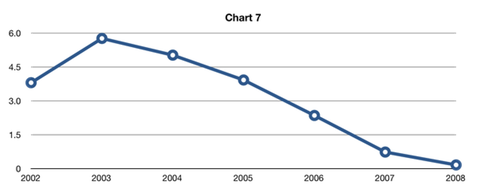
Same pattern. The graph looks basically identical to the Wii's.
This kind of console sales graph is nothing unusual. It's a typical console sales pattern. Many consoles peak in their second or third year, and then decline steadily after that. Why? During the first years, manufacturers are often still ramping up production. Then, after about two or three years on the market, two things usually happen:
- Console manufacturers lower the price substantially. Depending on how well a console sells, the exact time when this happens can change.
- The second generation of games come out; the ones that actually make good use of the hardware, and are compelling system sellers.
So that's when console sales are highest. After that, sales decline steadily, as a console's hardware becomes increasingly outdated, and more and more potential buyers already own the device.
The Wii's sales pattern is not unusual. It's not an indicator that anything special happened around 2008. It's a typical console sales pattern.
Do other consoles show the same peak around 2008?
If something special happened around 2008, you'd see that reflected in the sales patterns of the Wii's contemporaries. They should also peak in or around 2008.
Well, here's the PS3's sales pattern:4
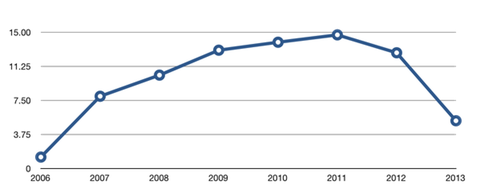
Asymco notes that the "combined Sony/Nintendo peak" was in 2008, making it sound as if the PS3's sales followed a similar trajectory. If you look at the actual data, the PS3 didn't peak in 2008 at all.
The PSP did peak around that time (which is unsurprising, because it launched three years earlier, and follows a typical console sales pattern). But the "combined Sony/Nintendo peak" is almost exclusively due to the Wii's peak in 2008. Sony's combined console sales do peak in 2008, but only barely. They continue selling steadily until 2011, and only start to decline at the end of the two consoles' lifespans.
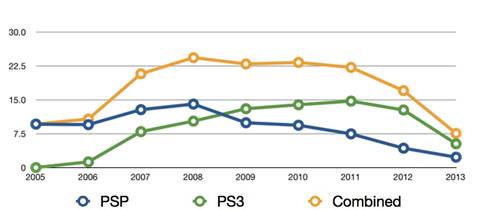
The Xbox 360's sales pattern looks very similar to the PS3's, and also peaks much later than 2008:
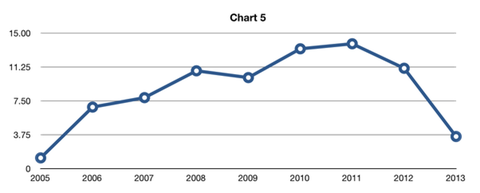
If you combine sales of all TV consoles, the 2008 peak simply disappears:

If the "post-PC era" truly had such a devastating effect on the console market that the Wii's sales just deflated after 2008, it's unlikely that the same effect would not also be seen in the PS3's and Xbox 360's sales. But Asymco's huge 2008 peak mainly exists because the Wii peaked in 2008, and because back then, it outsold its competitors by large margin.
In other words, many consoles show Wii-like sales curves - but not the Wii's direct competitors, the PS3 and the Xbox 360. If the Wii's sales peak in 2008 was indeed mainly caused by the "post-PC era", you'd expect the Wii's direct competitors to be similarly affected. They're not.
Is there a better explanation for the Wii's sales pattern?
If you go back up and compare the Wii to the PS2, you'll notice that the Wii declined much faster. If the "post-PC era" didn't cause the Wii's quicker decline, what did?
Look at the PS3 and Xbox 360's sales patterns: they start to really climb once the Wii starts to go down. I don't think it's hard to figure out what happened.
In 2007, a console that didn't support HD graphics was still acceptable — but only barely. Market share of HD TVs increased dramatically after 2008. Around the same time, both the PS3 and the Xbox 360 received substantial hardware revisions and price cuts, while third-party support for the Wii failed to materialize in any meaningful way. As a result, attention simply moved from the Wii to HD-capable consoles, which caused Wii sales to decline each year, and caused PS3 and Xbox 360 sales to peak much later than you'd expect in a typical console sales cycle.
Meanwhile, Nintendo's attempts to launch another Wii Sports-like success and get some more wind under the Wii's wings failed. They weren't nearly as compelling as Wii Sports, or even Wii Fit.
Look at the chart for combined TV console sales again:

It's pretty clear that TV console sales remained steady until 2011. Attention simply shifted from the Wii to the other two consoles.5
And what happened in 2011 to make console sales decline so suddenly? Well, that's when it became clear that Nintendo, Sony, and Microsoft would soon bring out new consoles. The Wii U was announced at E3 2011, and it was only a matter of time until the other two companies would follow suit. At the same time, developers received dev kits for the Xbox One and PS4, which caused leaks about the new consoles, and helped establish that they were not too far off.
Here's the same chart of total TV console sales, annotated with a few6 notable events that influenced console sales:

(Larger version of this chart)
Did the "post-PC era" have an influence on the Wii's sales? Maybe. But I don't see how they could be substantially different even without the iPhone and iPad. The "post-PC era" isn't required to explain the Wii's sales pattern.
So, what's the console market's future?
Who knows. Personally, I don't think much will change. There will always be a market for consoles, and there will always be more generic, multi-purpose devices competing with them.
People have always noticed when sales started to decline rapidly at the end of a console generation, and have always been very quick to proclaim the end of videogame consoles. At the end of the PS1's cycle, Asymco's exact same argument that could have been made. "Console sales are declining, and the Dreamcast, the first console of the new generation, is selling terribly! PCs have finally destroyed the market for videogame consoles!"
Historically, people attributed the console's demise to the power of PCs. Nowadays, it's smartphones and tablets that will supposedly kill consoles. And maybe that's true. Maybe this time really is different. But I doubt it.
There's really nothing unusual happening this time around. We've all seen this exact thing happening before. What Asymco's charts show is very likely not Apple crushing the console market. It's simply the end of a generation of consoles, and the beginning of another. Sales of the previous generation are petering off, and the new consoles haven't yet taken over. No need to panic. At least not just yet.
If nobody buys the PS4, then you should start panicking.
And with that, I promise that the next article I publish here will be about design, and have nothing to do with videogames.7
-
Sigh. I wish I could stop writing about videogames. I feel like I'm spamming my RSS feed with articles most of its subscribers really don't care about. So I hope this is the last article on this topic. Fingers crossed. ↩︎
-
Before you can start to figure out which genus Bigfoot belongs to, you should establish that he actually exists. ↩︎
-
The PS2 peaked a little later and declined much less rapidly than the Wii, but that's mainly because it didn't have any real competition. The Gamecube and the Xbox never sold well, so the PS2 had the market to itself. It's no coincidence that the PS2 ended up being the best-selling console of all time.
This cycle, on the other hand, the Wii was completely outdated the day it came out, and the Xbox 360 and particularly the PS3 peaked later during the Wii's life. Both of these factors helped the Wii's decline. ↩︎ -
Note that these charts make the decline in 2013 look steeper than it really is, because we're only in September, and haven't yet had the 2013 holiday sales. ↩︎
-
If anything, combined console sales during this generation of consoles was much steadier than during the previous. ↩︎
-
Yes, I realize that I'm leaving off dozens and dozens of relevant things. If there's something specific you have in mind that really should be on the list, please do tell me, but keep in mind that I can't put dozens of things on such a tiny chart :-) ↩︎
If you require a short url to link to this article, please use http://ignco.de/550




